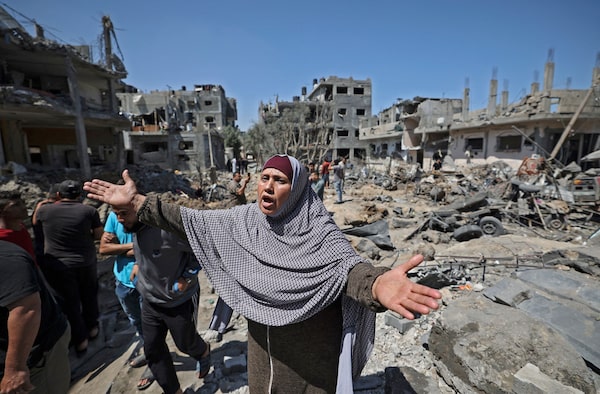
A Palestinian woman gestures as residents of Beit Hanun, in the northern Gaza Strip, assess the damage from Israeli air strikes on May 14.MAHMUD HAMS/AFP via Getty Images
After a week of warfare between Israel and Hamas, streets in Gaza are a shattered mess, with chunks of concrete and twisted metal sprawled where multistorey buildings once stood. Pockets of Israeli cities such as Tel Aviv, Ashkelon and Ashdod are smouldering too, in the places where Hamas rockets shot through Israel’s anti-missile defences with deadly effect.
Just as shocking is the blood that has been spilled on the streets of several ethnically mixed Israeli cities. On Wednesday, a mob of Jewish residents of Bat Yam, on the edge of Tel Aviv, were captured on video beating an Arab man, continuing to kick him and hit him with the Israeli flag even after he had obviously lost consciousness. In the central Israeli city of Lod, gangs of Arab and Jewish youths have repeatedly clashed, and four synagogues have been set ablaze.
Listen to The Decibel: A deadly week in Israel and the Palestinian Territories
From the archives: Three storeys - and a nation - built by tragedy
Thousands of border police, usually deployed in the occupied West Bank, have been sent to mixed Israeli cities in an effort to keep the violence from spreading.
While the Gaza fighting has been far deadlier – 132 Palestinians and eight Israelis have been killed so far in the worst eruption since 2014 – some worry that the rioting and vigilantism in places like Bat Yam and Lod could portend a broader conflict between Jews and Arabs across Israel and the Palestinian territories, and perhaps even the wider neighbourhood.
“Honestly, I think the internal problem is more serious than what’s happening in Gaza,” said Mitchell Barak, a Jerusalem-based pollster and political analyst. “We went into a mosque and they went into synagogues,” he said, referring to Monday’s move by Israeli police to clear worshippers and some stone-throwing protesters out of the Al-Aqsa mosque in Jerusalem, a move that led to Hamas launching its first barrage. “It’s civil unrest, and I don’t see how it ends.”
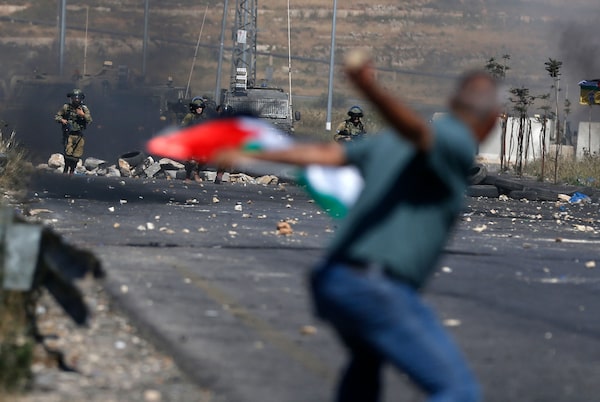
A Palestinian man hurls rocks at Israeli security forces near the Jewish settlement of Beit El in the occupied West Bank on May 14.ABBAS MOMANI/AFP via Getty Images
Separately, 11 Palestinians were killed Friday in clashes that saw stone-throwing protesters confronting soldiers in several cities in the Israeli-occupied West Bank.
There were also attempts to breach Israel’s borders with Jordan and Lebanon, both of which are home to large populations of Palestinian refugees. One Lebanese national was reportedly killed after Israel said tanks had fired warning shots at the crowd that attempted to break through its northern border fence.
The animosity can be traced all the way back to the 1948 war that led to the creation of Israel – an event Palestinians refer to as the “naqba” or “catastrophe.” The 73rd anniversary will be marked on Saturday by more protests in the West Bank, and almost certainly with another round of violence in Gaza, which Israel has blockaded since Hamas seized power there in 2006.
More than seven decades on, Israelis and Palestinians still struggle to understand each other’s versions of 1948.
To Israelis, the year marked the creation of the world’s only Jewish state, which became a haven for survivors of the Holocaust and their descendants. To Palestinians, it’s the year hundreds of thousands of people lost their homes, the beginning of mass dispossession and oppression that has lasted for generations.
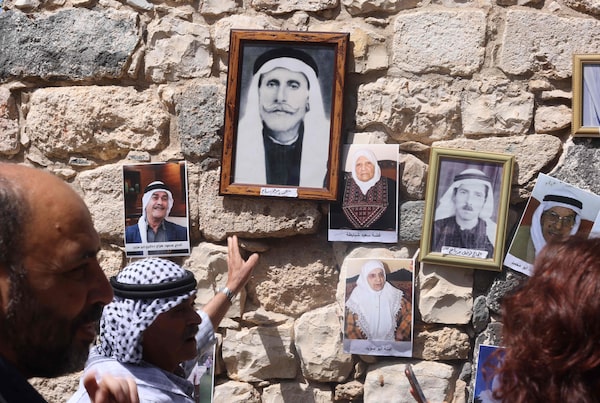
Arab Israeli protesters look at pictures from the abandoned Arab village of Kfar Hattin at an April 15 protest calling for the right of Palestinian refugees to return after Israel's 1948 war of independence.AHMAD GHARABLI/AFP via Getty Images
People with Israeli flags watch as Israeli Air Force planes fly in formation during an April 15 aerial show, part of this year's independence celebrations.Ammar Awad/Reuters
If Lod, a city of 80,000 that is now under nighttime curfew, was famous for anything before this week’s violence, it might be Tamer Nafar. But Mr. Nafar – a Tupac Shakur-inspired rapper who performs in Arabic, Hebrew and English – is sadly unsurprised to see the citizens of his city turning on each other.
Anger among the Arab minority, who make up roughly 30 per cent of the population of Lod, and 20 per cent of Israel, has been building for decades, Mr. Nafar said. Arab residents of the city, such as Mr. Nafar, are prevented from building even small additions to their homes while the Jewish part of Lod expands around them. Meanwhile, a more-belligerent Jewish nationalism has been unleashed over the 12 years that right-winger Benjamin Netanyahu has been Prime Minister.
“You see it coming, but it still surprises you,” Mr. Nafar said in a telephone interview. As he spoke, the father of two described a convoy of cars that was driving past his house. The occupants of the vehicles were waving Israeli flags and chanting “Death to Arabs.”
Mr. Nafar said the problems in the city – which is known as one of the highest crime districts in Israel, something Mr. Nafar blames on police neglect – could be traced all the way back to 1948, when Lod was the scene of one of the largest forced expulsions of Arab residents. The Palestinians who remained, he said, have never felt equal or comfortable in Israel, nor have they forgotten the history of their city.
“Everybody knows about the naqba. It’s something you hear about from your grandmother, even if you don’t understand politics. It’s something we pass on. It’s one of the only ways to keep the tragedy alive, even though it’s unrecognized in Israel.”
The violence was flowing in both directions in Lod on Friday. Two Jewish Israelis were reportedly shot and killed in the city, and there were videos of Israeli police protecting Jewish nationalists as they threw stones at Arabs. There were also reports of unrest in other ethnically mixed cities, including Jerusalem and the ports of Jaffa and Haifa.
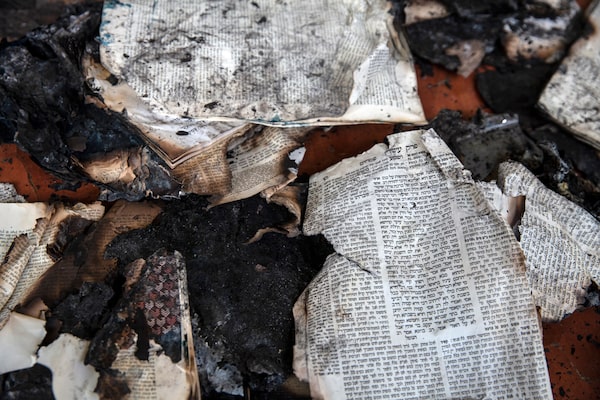
Burned Talmud books are piled at the synagogue of the Maoz Military Preparation Program in Lod, Israel, on May 14 after it was damaged by fire during overnight clashes in the mixed Jewish-Arab city.Heidi Levine/The Associated Press
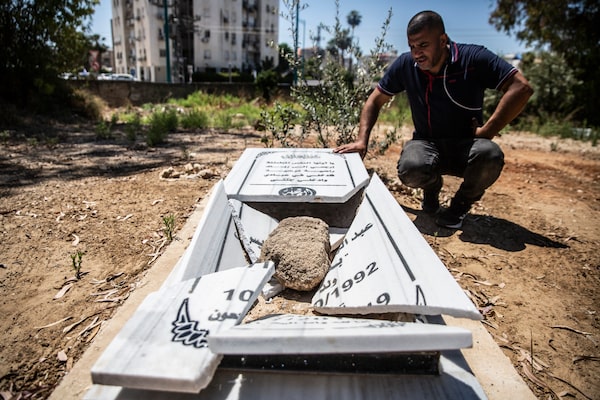
Lod resident Jamal Abu Kasher looks at one of several vandalized graves in a Muslim cemetery.Heidi Levine/The Associated Press
In a statement that some condemned as racist, Israeli President Reuven Rivlin made it clear that he saw his country’s Arab citizens as responsible for the violence.
“The sight of the pogrom in Lod and the disturbances across the country by an incited and bloodthirsty Arab mob, injuring people, damaging property and even attacking sacred Jewish spaces is unforgivable,” Mr. Rivlin wrote Wednesday on Twitter.
As the violence continued, Mr. Rivlin’s social-media postings took a more conciliatory tone later in the week. “Extremists must not set the tone,” he wrote on Thursday. “We the moderate majority, Jews and Arabs, want to continue to live here together.”
The communal violence challenges Israel’s definition of itself as a democratic state that treats its citizens equally. A recent report by New York-based Human Rights Watch that accused Israel of committing “apartheid” in its treatment of Palestinians both inside Israel, as well as in the Palestinian territories, was robustly attacked by the government as anti-Israel propaganda.
This week’s violence erupted just as Israel appeared to be approaching a major political milestone – the possible formation of a coalition government that for the first time would include an Arab party. But the odds of right-wing opponents of Mr. Netanyahu sitting together with the United Arab List appear remote after the unrest.
That leaves Mr. Netanyahu – who earlier tried and failed to form a coalition government of his own – in office as acting prime minister, and potentially puts the country on a course for its fifth election in just over two years.
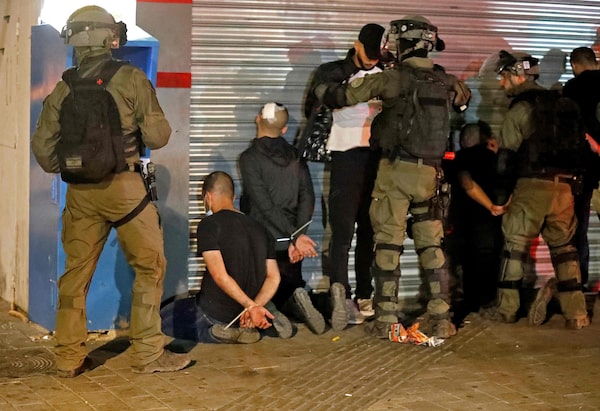
Israeli forces detain a group of Arab Israelis in Lod on May 13.AHMAD GHARABLI/AFP via Getty Images
Tamar Hermann, a senior research fellow at the Israel Democracy Institute, said the violence was disheartening because years of polling had shown that personal relations between Israel’s Arab and Jewish communities had been improving, even as Israeli Arabs continued to feel alienated from the state and its institutions.
She said Mr. Netanyahu deserved much of the blame because he had courted the far-right Jewish Power movement headed by Itamar Ben Gvir, who won a parliamentary seat for the first time in the inconclusive March election that preceded the coalition wrangling.
Prof. Hermann described Mr. Ben Gvir and Jewish Power – both have made inflammatory visits to the East Jerusalem neighbourhood of Sheikh Jarrah that is at the centre of many of the tensions in that city – as “neo-Nazi Jews, if that combination is possible.” On Friday, Israel’s Channel 12 television reported that police chief Kobi Shabtai had told Mr. Netanyahu that Mr. Ben Gvir was the single person most responsible for the outbreak of violence.
“What we’ve seen is the legitimization of the kind of politics that until recently was ostracized by everybody,” Prof. Hermann said. “Previously, even people on the right avoided contact with [Mr. Ben Gvir]. But now, Netanyahu has opened the door for him.”
In Gaza, 67-year-old Jamal Abu Khalid – whose family are refugees from Lod and the 1948 war – spent Friday trying to calm his grandchildren after an Israeli air strike destroyed a home 30 metres away from his own house, killing two of the building’s residents and injuring three others. Though Israel says it’s only targeting Hamas, Mr. Abu Khalid said the owner of the home was a teacher with no known connections to the militant group.
“Life in Gaza is getting worse every day,” Mr. Abu Khalid said. Like many Palestinians, he said he had given up hoping for an independent state, and now wanted to see Israelis and Palestinians live in a single country, with equal rights for all. “Then we can live in peace. I visited Lod many times, and I hope my sons will return one day.”
That day continues to appear a long way off. On Friday, Gaza residents fled the north of the coastal territory as Israeli tanks and artillery pounded the area in preparation for a possible ground invasion. Israel, which has carried out more than 600 air strikes since Monday, has vowed to crush the offensive capability of Hamas, which has fired more than 1,800 rockets over that time.
With reporting by Hasan Jaber in Gaza City
/www.theglobeandmail.com/resizer/3CRGq8mTGboL6Svhps848k0Ap7g=/arc-anglerfish-tgam-prod-tgam/STOXIE6UXBJGVLD6UTBCHY76LY.jpg) The Decibel: What is happening in Israel and the Palestinian Territories?
The Decibel: What is happening in Israel and the Palestinian Territories?
Senior international correspondent Mark MacKinnon discusses the forces at play behind the recent violence between Israel and Palestinians, and where this conflict is headed.
Our Morning Update and Evening Update newsletters are written by Globe editors, giving you a concise summary of the day’s most important headlines. Sign up today.
 Mark MacKinnon
Mark MacKinnon